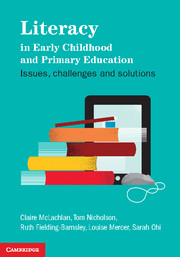Book contents
- Frontmatter
- Contents
- List of figures
- List of tables
- About the authors
- Acknowledgements
- Chapter 1 Introduction
- Part 1 Literacy acquisition: the child, the family and diversity in the modern world
- Part 2 Learning about literacy in early childhood settings
- Part 3 Literacy learning in the primary school
- Chapter 10 The first year of primary school: building on foundations
- Chapter 11 Establishing a community of readers
- Chapter 12 Uses of assessment in the primary school years
- Chapter 13 Reading and writing in the primary school: focus on narrative writing
- Part 4 Literacy learning in the senior primary school
- References
- Index
- References
Chapter 11 - Establishing a community of readers
from Part 3 - Literacy learning in the primary school
- Frontmatter
- Contents
- List of figures
- List of tables
- About the authors
- Acknowledgements
- Chapter 1 Introduction
- Part 1 Literacy acquisition: the child, the family and diversity in the modern world
- Part 2 Learning about literacy in early childhood settings
- Part 3 Literacy learning in the primary school
- Chapter 10 The first year of primary school: building on foundations
- Chapter 11 Establishing a community of readers
- Chapter 12 Uses of assessment in the primary school years
- Chapter 13 Reading and writing in the primary school: focus on narrative writing
- Part 4 Literacy learning in the senior primary school
- References
- Index
- References
Summary
Chapter objectives
To identify the principles for catering for diverse learners in the primary classroom.
To explain in detail how to set up effective reading programs in the primary classroom.
To explore the concept of a community of readers and how to establish one within a classroom setting.
What does it mean to have a classroom of eager readers who love to talk books? How do teachers create collaborative processes where all readers know that the teacher hears and respects their opinions? How does a teacher get momentum happening so that learners want to read beyond the classroom walls? Catering for diversity in classrooms is also the focus of this chapter. It leads into the notion of what it means to have a negotiated curriculum where learners make choices about what they value when it comes to reading. It looks at incorporating a variety of perspectives that acknowledge the variety of interests and experiences learners have to contribute to curriculum. This is a practical chapter about planning and organising a classroom for learning. It contains the ‘nitty-gritty’ of how to be equipped for effective instruction for K–6 learners.
- Type
- Chapter
- Information
- Literacy in Early Childhood and Primary EducationIssues, Challenges, Solutions, pp. 187 - 208Publisher: Cambridge University PressPrint publication year: 2012

